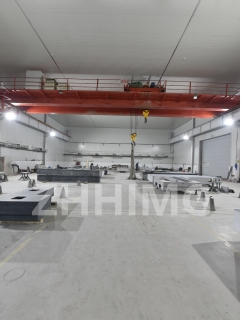Precision granite is a type of material used in the manufacturing industry that possesses excellent dimensional stability, high mechanical strength, and a low coefficient of thermal expansion. These properties make precision granite perfect for use in applications that require the utmost accuracy in measurement and positioning. One specific application that has benefitted greatly from the use of precision granite is the optical waveguide positioning device. In this article, we will discuss the advantages and disadvantages of using precision granite for such a device.
Advantages:
1. High precision: One of the most significant advantages of using precision granite for an optical waveguide positioning device is its high level of precision. Granite has excellent dimensional stability, which means it can maintain accurate dimensions and tolerances over a wide range of temperatures. This property makes it ideal for use in applications that require tight tolerances, such as the optical waveguide positioning device.
2. Durable: Granite is known for its excellent mechanical strength and durability. It is resistant to corrosion, wear, and tear and does not easily deform under stress. These properties make it perfect for use in harsh environments, and it can withstand constant use and pressure.
3. Accurate measurement: Precision granite is used to produce the base of the optical waveguide positioning device, which stabilizes and secures the fiber optics. With the help of the precision granite, the device can accurately measure and position the fiber optics, facilitating precise placement and alignment, resulting in a more accurate output.
4. Low coefficient of thermal expansion: Granite has a low coefficient of thermal expansion, making it impervious to temperature fluctuations. This property ensures that the positioning device will remain stable and accurate even when exposed to temperature changes.
5. Easy to maintain: Precision granite is relatively easy to maintain. It does not rust or corrode, and it can withstand a wide range of harsh environmental conditions without losing its properties. Therefore, maintenance costs associated with the optical waveguide positioning device that uses precision granite are significantly lower.
Disadvantages:
1. Heavyweight: Granite is a heavy material, which makes it unsuitable for applications that require lightweight structures. The substantial weight of the precision granite can affect the portability of the device.
2. Fragile: Although precision granite is a durable material, it is fragile for any significant impact, and the device will need to be thoroughly examined or replaced, which can be time-consuming and expensive.
3. Costly: Precision granite is costly compared to other materials. The cost of purchasing, designing, and machining the granite to the appropriate specifications can be high, which can increase the cost of the optical waveguide positioning device.
4. Machining limitations: Machining precision granite is a challenging task that requires skilled labor and special equipment. This can limit the design flexibility of the optical waveguide positioning device, and it can also take a longer time to manufacture the device.
Conclusion:
To summarize, precision granite is an excellent material with numerous advantages when used for optical waveguide positioning devices. The material's high precision, low coefficient of thermal expansion, and durability make it a desirable choice for applications that require precise measurement and accurate positioning. Although the substantial weight, cost, fragility, and limited design flexibility of precision granite are challenges, the benefits of using precision granite outweigh the disadvantages. Therefore, it is safe to say that a precision granite optical waveguide positioning device is a reliable, durable, and highly accurate device that can be used in harsh environmental conditions with minimum maintenance required.
Post time: Dec-01-2023

